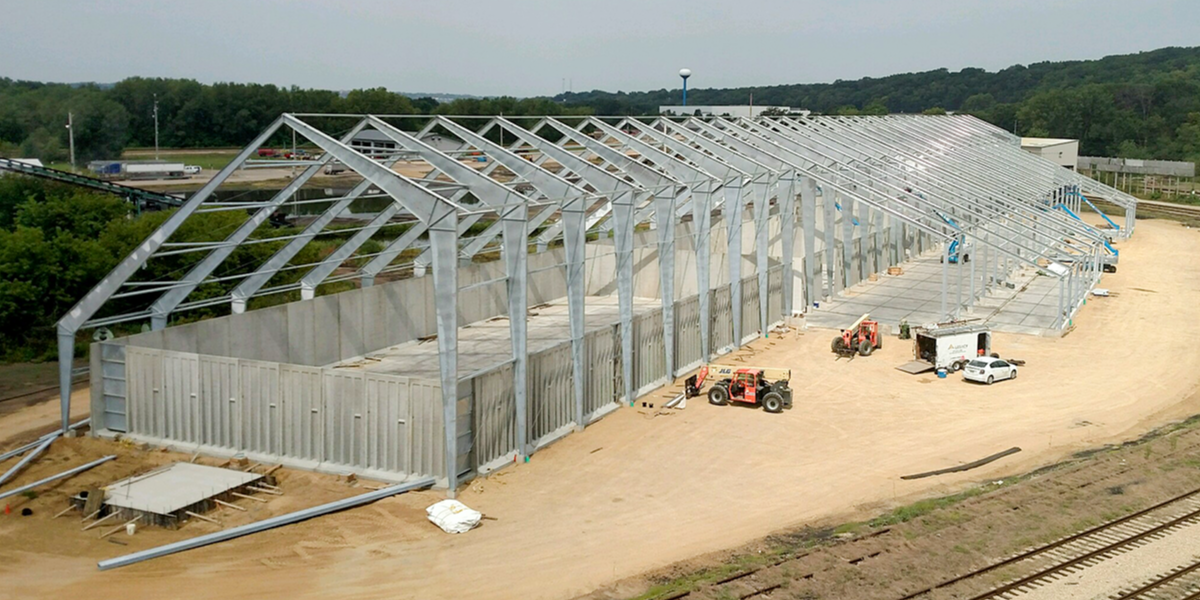7 Common Mistakes in Fabric Building Construction

7 Common Mistakes in Fabric Building Construction
There are as many standards for fabric structure construction as there are manufacturers. While no builder can guarantee that their structure is 100% safe, avoiding a few common pitfalls increases the building safety and reliability. Here are some things to watch out for before construction begins.
1. Trusting open web trusses.
Open web trusses consist of hollow tubes welded together to create a semi-circular frame. Open web trusses were once the norm for fabric building construction due to their relatively low price and light weight. However, when compared to solid steel I-beams, it’s easy to spot some important differences.
The basis of an open web truss is a series of hollow tubes. These tubes conceal nearly half their surface area inside the tube. If corrosion starts inside the tube, there’s no way to detect it until the rust has eaten through the tube – far too late to repair the truss.
Each individual tube of a web truss is then welded together. Every weld presents another potential failure point.
Learn more about the solid steel frames used in Legacy buildings.
A rigid frame is made of steel I-beams. Rigid frames are the preferred framing material in all types of construction, including large skyscrapers. Each I-beam is made of a solid piece of steel and then hot dip galvanized or painted as a whole.
There are no unseen interior areas and no welds. The strength of rigid frames is designed and proven by complex software with manual quality checks.
2. Using a mono-cover fabric membrane.
Mono-cover buildings have just one large piece of fabric stretched over the top of the building. The cover is attached to the end frame members, and the center frames support the fabric from below but are not attached. In a mono-cover fabric building, the weight and pressure of the fabric are applied to just two frames.
Additional pressure on the fabric – from strong winds, for example – are passed on to the frames and may be too much for the frames to handle, causing the frames to sway or even fall completely, bringing the entire building down. Similarly, a rip in the fabric can easily spread across the entire cover, leaving anything inside the building vulnerable to the elements.
Individual panels attached to each framing member are much safer. The fabric pressure is evenly distributed among the frames, protecting any one frame from overstressing. Even if there is a strong force inside or outside the building, the fabric is securely attached to each frame and will not pull on other framing members. If one panel rips, it is easily repaired without the expense and hassle of re-covering the entire building.
3. Relying on fabric tension to provide stability to the structure.
Many fabric structure manufacturers rely on the fabric itself to provide lateral support to the rigid frame top flange. Unfortunately, in the case of loose fabric or a failed panel, the flange will be unsupported and the building may fail.
When a fabric structure is built on a rigid steel frame, purlins bracing the bottom flange and the flange braces come off of the purlins bracing the top flange at certain spacings. The fabric does not even have to be on the building in order for the rigid frame to have the lateral bracing it was designed for. Though the fabric does serve as a redundant lateral brace for the top flange, it is not relied upon for the stability of these structures.
4. Not engineering to local codes.
Local building codes contain minimum requirements for the snow, wind and seismic forces that must be absorbed by the building. These codes are written based on typical weather phenomenon in your area. If a building does not meet code requirements, it is likely to fail during a typical weather event.
Pre-fabricated buildings are a tempting choice due to their low price and easy availability. However, pre-fab buildings are not designed to meet codes, and they are not designed to last through weather events. Only by having your building designed and stamped for your area can you ensure that your building is up to code.
5. Allowing inexperienced crews to install fabric buildings.
Fabric structure installation is a specialized process. As with most jobs, experienced crews bring the tools and the know-how to install the building correctly, safely and efficiently. While it may be tempting to attempt to install the building yourself or with the help of traditional builders, it will never be done as well as it is with qualified, experienced fabric building installers.
6. Not using a proper foundation.
The foundation of a fabric building supports the building during everyday use and extreme conditions, such as weather or accidental collision. An inadequate building foundation will not support the building, and may contribute to collapse.
Some fabric building manufacturers claim that the structure is temporary and does not require a foundation. However, “temporary” in buildings typically means only a few days – not months or years. In order to ensure long-term building safety, some type of foundation is required.
An engineered fabric structure may be customized to use a wide variety of foundation types. While not all building conditions allow for a heavy cast-in-place foundation, a qualified engineer should suggest a foundation that will work in the soil conditions and provide adequate support for the structure.
7. Compromising on your building vision.
When fabric structures are built with the same foundation and frame as traditional buildings, they are equally safe. While there’s no way to completely prevent accidents and tragedies from occurring, choosing a fabric-covered building gives you the same peace of mind – as well as customization and options – as any other type of construction. Don’t settle for a builder who insists on compromise – your safety depends on it.
